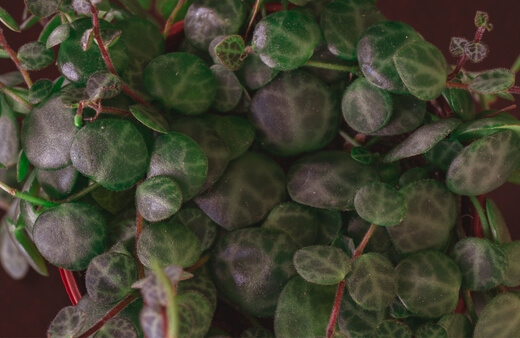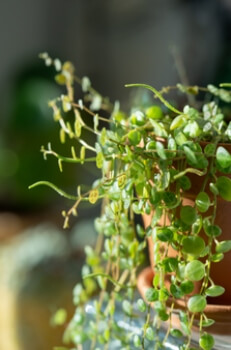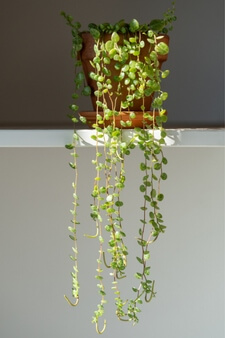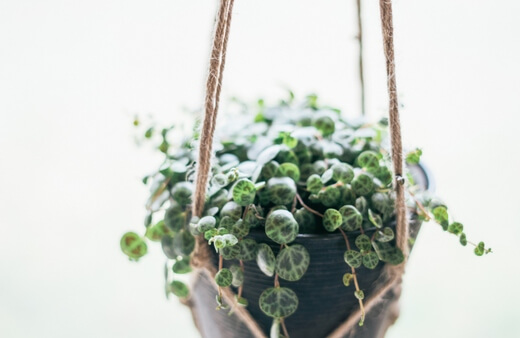So, you’re someone who loves indoor plants but is far too busy for hassle? Not a problem. The Peperomia prostrata is an incredibly easy-growing and problem free variety of the peperomia species.
With intricate, printed leaves and soft white blooms this tropical perennial is perfect for novice gardeners or those on the go. From propagation to proper care, here's everything you need to know to grow Peperomia prostrata.
More...

String of Turtles Plant Introduction
Part of the Piperacae family, peperomia plants have thousands of incredible cultivars that seem to be increasingly popular for indoor gardening. Known for their hardiness and eclectic looks, these perennials are perfect for any one hoping to grow a few extra plants within their home.
The prostrata cultivator is native to Brazil and easily identified by it’s curious heart-shaped leaves which resemble the shell of a turtle. In the right conditions, these vining plants will produce small, non-fragrant blooms year round.
Although vines can easily reach anywhere between 1 and 1 ½ feet, prostrata plants are considered slow growing and entirely non-invasive.
How to Grow String of Turtles Plant

As long as you give your Peperomia prostrata the right growing conditions, you really shouldn’t have much issues with it. Plus, propagation is fairly simple so you can enjoy plenty of little plants all around your home.
Keep your Peperomia prostrata in a position which receives average, indirect light or sunlight throughout the day. Young plants do well when receiving some direct morning or evening sunlight.
However, take extreme care to not leave your in direct sunlight for too long and this will cause your soil to dry out too quickly and your leaves to scald.
This cultivar can even be grown under growing lights in regions which don’t receive much sunlight. The key factor you’ll need to consider before propagating is preparing the right soil.
Due to its tropical roots, Peperomia prostrata prefer loamy and wet conditions. However, waterlogging can be problematic, so ensure your soil retains moisture but drains well.
How to Propagate String of Turtles

Propagation is incredibly easy either from root, stem or even a leaf cutting. Propagation should be carried out in March.
Here’s our step-by-step guide for easy propagation:
- Use a sharp blade to remove a vine cutting of approximately 5 inches long, with some healthy leaves.
- Coil the vine into a circle.
- Fill a small pot with fresh potting mix. Place the coil on the surface, take care not to cover the vine nor leaves with soil.
- Do not water the cutting for the first week. Thereafter, moisten the soil once a week through misting.
- Keep your cutting near bright, indirect light. Should any leaves wither or yellow, remove them.
- Once it begins to root, you’re ready to plant.
Planting Peperomia prostrata
You’ll want to choose small, shallow containers or pots for Peperomia prostrata as they have a relatively small root system. It is recommended to use a potting mix which is 2 parts peat moss for every one part perlite or sand.
Simple dig a hole big enough for the new roots, plant and gently cover with soil. Add a fresh layer of soil on-top once a year to refresh your plant.
(Previously we recommended using peat/sphagnum moss. However, given its environmental impact, we have shifted our guidance to less impactful alternatives that are just as good or if not better. Check out our guide if you want to discover peat moss and its alternatives.)
String of Turtles Care Tips

Most cultivars of peperomia don’t enjoy being re-potted regularly, so you’ll only need to worry about occasional watering, fertilising and pruning. Peperomia prostrata have sensitive leaves so take care whenever watering or pruning so as not to damage the plant.
Excessive leaf shed could, however, be a result of over-watering.
Watering Peperomia prostrata
Peperomia are considered succulents, so water sparingly. Established plants should only be watered every 2 to 3 weeks. Bottom watering seems to be an effective technique to provide moisture and promote root growth.
Simply submerge the base of your pot in water for 10 minutes, then remove and allow to drain. In colder months, you can cut back significantly. In particularly dry seasons consider supporting your Peperomia prostrata with some additional humidity by placing it on a gravel tray.
Fertilisation
You’ll want to fertilise regularly throughout the growing season, around every two weeks. For maximum absorption opt for a water-soluble or slow release fertiliser. The added nutrient boost will help to maintain your leaf color and pattern.
Pruning
Regular pinching back of leggy stems will help to manage plant size and stimulate bushy growth. Use a sharp knife, sterilized scissors, or pruning shears to cut back as much as 2 to 3 inches. Old flowers can also be removed once they begin to wilt.
Common Peperomia prostrata Pest and Diseases
Much like it’s peperomia counterparts, this cultivar is not necessarily prone to problems and issues normally only arise when over-watered.
Root Rot
Root rot is a common result of over-watering. Rot will stunt the growth of your Peperomia prostrata and kill off leaves. Luckily, if detected early enough, re-planting in fresh soil and cutting back on watering will be able to save your plant.
Mealybugs
Noticing some white fuzzy insects on your plants? Mealybugs are a real pain and can arise when over-watering or over-feeding your Peperomia prostrata. Treat your plant with an alcohol solution to kill and repel these pesky bugs.
Spider Mites
Another indoor critter, you don’t want near your plants. Spider-mite infestations can be tricky as they can spread. Be sure to move your plant away from other plants when treating.
Peperomia prostrata Application in Your Home

This vining perennial is perfect for most indoor applications. As long as it’s getting the right amount of light, it’ll be fairly happy and as it doesn’t need daily care, it’s even a great choice for business or work spaces.
Use your Peperomia prostrata in:
- Hanging Baskets. Whether in your bathroom, kitchen or bedroom, hanging baskets are cool and look great with long, spindly plants.
- On Window Sills. Provided it’s not on a window sill that gets full sun exposure, your Peperomia prostrata will love the fresh air.
- As a Terrarium Plant. Terrariums are all the rage right now and as Peperomia prostrata are non-invasive, they’ll work great alongside other plants.
String of Turtles Frequently Asked Questions
Why are my peperomia leaves turning yellow?
Yellowing of leaves is a direct sign of water-logged soil. Immediately, re-pot and cut back on watering. Remove any dead leaves or vines with a sharp knife.
Why are the leaves in my Peperomia prostrata turning red?
A reddening of foliage is unique to Peperomia prostrata and comes from an over-exposure to direct sunlight. If at all, this species can only tolerate one or two hours of morning or evening sunlight.
Can peperomia plants grow in low light?
Peperomia plants can tolerate low light conditions, but you’ll quickly notice a lack of vibrancy and color. Avoid keeping your plants in dark corners.
Should you notice your plant beginning to dull and droop, move into a position which receives more light and cuts off any dead or wilted leaves.
Can you grow Peperomia prostrata outdoors?
While you can potentially find a workable spot, it is rather difficult. If planting outside, consider keeping it inside a greenhouse or under some sort of cover.
For more Peperomia varieties, see our growing guides list below:
Exploring additional varieties of string plants to enrich your collection? Check out our list of string plants suitable for growing in your home.
Wrapping Up Our String of Turtles Growing and Care Guide
No matter where you decide to plant it, Peperomia prostrata are a great choice when it comes picking an indoor plant. While you won’t need to pay too much attention to watering, just ensure you’re giving it enough moisture now and then.
In general, keep an eye out for wilted leaves and adapt your watering schedule accordingly. For best results, wait until spring before propagating. Whether you call it a string of turtles, a string of pearls or anything else, String of turtles are a pretty, hassle-free addition to any home.
Published on December 27, 2022 by Lorri Hopkins
Last Updated on February 1, 2024




